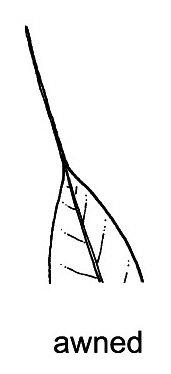|
|
 |
Key to FestucaView taxon page for Festuca
(For a list of species in Festuca, use the above link.) Jepson Manual glossary definitions can be seen by moving your cursor over words underlined with dots. 1. Inflorescence spike-like (sometimes sparingly branched); glume  In Poaceae, each of generally two sheathing bracts that are the lowermost parts of a spikelet, subtending one or more florets. 1 except 2 in uppermost spikelet  1. In Poaceae, one or more florets (each a flower with subtending lemma and generally palea) and generally 2 subtending glumes; in a sterile spikelet, the flower(s) and sometimes palea(s) are rudimentary or absent. 2. In Cyperaceae, the smallest aggregation of flowers (generally more than 2) and associated bracts. (subg. Lolium) 2. Glume < rest of spikelet; lower lemma  In Poaceae, the lower, generally larger of two sheathing bracts subtending a flower, generally ensheathing the palea (in a sterile lemma, the associated flower and sometimes palea are rudimentary or absent); with the palea and flower, comprising the floret. firmly membranous, flat to rounded at base ..... F. perennis 1' Inflorescence panicle-like, branches dense and appressed  Parallel or nearly parallel to and often in contact with surface of origin; used to describe the disposition of hairs, leaves, pedicels, etc. to open and spreading  Oriented more or less perpendicularly to the axis of attachment; often, more or less horizontal. , or raceme-like; glumes 2, lower sometimes minute 3. Dioecious; spikelets  1. In Poaceae, one or more florets (each a flower with subtending lemma and generally palea) and generally 2 subtending glumes; in a sterile spikelet, the flower(s) and sometimes palea(s) are rudimentary or absent. 2. In Cyperaceae, the smallest aggregation of flowers (generally more than 2) and associated bracts. staminate or pistillate; reduced, sterile pistils sometimes present (subg. Leucopoa) ..... F. kingii 3' Bisexual; florets  In Poaceae, a single flower and its immediately subtending bracts (lemma and generally palea, the lemma subtending the palea when the latter is present); in a sterile floret, the flower and sometimes palea are rudimentary or absent. generally bisexual  Both male and female reproductive parts occurring and functional in the same plant or structure (e.g., flower, spikelet, inflorescence). 4. Leaf blade  Expanded portion of a leaf, petal, or other structure, generally flat but sometimes rolled, cylindric, wavy, or cupped. with prominent claw-like or clasping basal  At or near the base of a plant or plant part. Especially said of leaves clustered near the ground or of a placenta confined to the base of an ovary. auricles (subg. Schedonorus) 5. Auricles hairy (sometimes reduced to only 1 or 2 hairs); lemma generally minutely hairy, awn  1. Bristle-like appendage or elongation, generally terminal. 2. Stiff, needle-like pappus element in Asteraceae. 0.5–4 mm or 0 ..... F. arundinacea 4' Leaf blade generally without prominent claw-like, clasping basal auricles (inconspicuous flap-like auricles sometimes present) 6. Annual; stamen 1 (subg. Vulpia) 7' Lower glume generally > 3 mm, >= 1/2 upper glume (2–3 mm, < 1/2 upper glume in some Festuca microstachys) 8. Florets (5)7–12, closely overlapping, spikelet axis hidden; lemma awn 0.5–5 mm ..... F. octoflora 8' Florets generally 1–7, loosely overlapping, spikelet axis visible, each internode  Segment of an axis (generally a stem) between successive positions (nodes) from which one or more structures (especially leaves, buds, branches, or flowers) arise. > 1 mm; lemma awn 3.5–12 mm 9. Lowest inflorescence branches appressed to erect  Upright; vertically oriented. at maturity; branches without basal swellings ..... F. bromoides 9' Lowest inflorescence branches spreading or reflexed  Abruptly bent or curved downward or backward. at maturity; branches with basal swellings ..... F. microstachys 6' Perennial herb; stamens generally 3 (subg. Festuca) 10. Leaf sheath  A surrounding or partially surrounding, often tubular structure or part of a structure, such as a leaf base in Apiaceae or Poaceae. closed, ± red, hairs ± downward-pointing ..... F. rubra 10' Leaf sheath open at least 1/2 its length, generally green, glabrous or hairy, hairs not downward-pointing 11' Spikelet axis not jointed 12. Leaf blade generally (1)2–10 mm wide, flat or rolled longitudinally 13. Collar generally densely hairy (glabrous); lemma awn (0)1.5–2.5 mm, generally < 1/3 lemma; plants densely cespitose  Having a densely clumped, tufted, matted, or cushion-like growth form. , with persistent dead leaf  Organ arising from a stem, generally composed of a stalk (petiole) and a flat, expanded, green, photosynthetic area (blade); distinguished from a leaflet by the presence in its axil of a bud, branch, thorn, or flower; sometimes with lateral, basal appendages (stipules); either simple (toothed, lobed, or dissected but not divided into leaflets) or compound (divided into leaflets). sheaths at base ..... F. californica (2) 13' Collar glabrous; lemma awn 2–20 mm, generally > 1/3 lemma; plants loosely cespitose, dead leaf sheaths inconspicuous or 0 12' Leaf blade < 2.5 mm wide, folded or rolled inward toward upper side 15. Collar generally densely hairy, rarely glabrous; plants densely cespitose, with persistent dead leaf sheaths at base ..... F. californica (2) 15' Collar glabrous; plants loosely to densely cespitose, without persistent dead leaf sheaths at base (except Festuca idahoensis) 16. Lemma awns  1. Bristle-like appendage or elongation, generally terminal. 2. Stiff, needle-like pappus element in Asteraceae. 3–12 mm 18. Spikelets 9–12 mm; lower cauline leaf blades much shorter and stiffer than the upper ..... F. viridula 18' Spikelets 2.5–9 mm; upper and lower cauline leaf blades similar 19' Anthers when dry 0.5–2 mm; plants of subalpine or lower alpine habitats, generally > 3000 m 20' Anthers 0.4–0.8(0.9) mm when dry
Please use this Google Form for Contact/Feedback
Citation for the whole project: Jepson Flora Project (eds.) . Jepson eFlora, https://ucjeps.berkeley.edu/eflora/ [accessed on ]
Citation for an individual treatment: [Author of taxon treatment] [year]. [Taxon name] in Jepson Flora Project (eds.) Jepson eFlora, [URL for treatment]. Accessed on .
We encourage links to these pages, but the content may not be downloaded for reposting, repackaging, redistributing, or sale in any form, without written permission from The Jepson Herbarium.
|
|
 |

